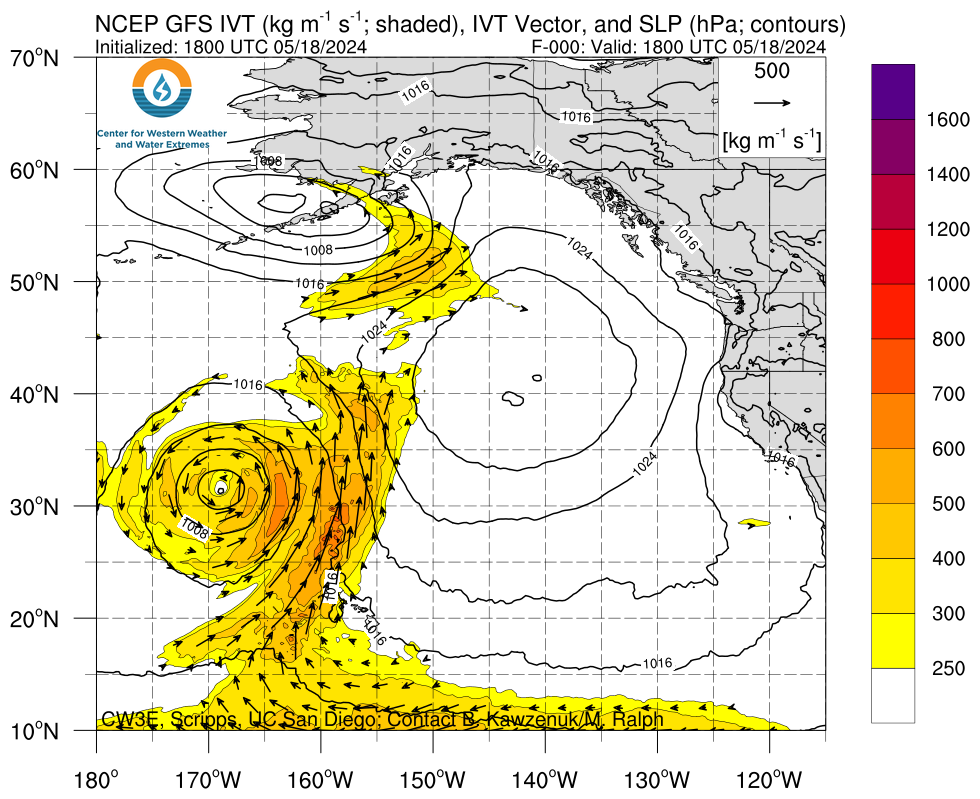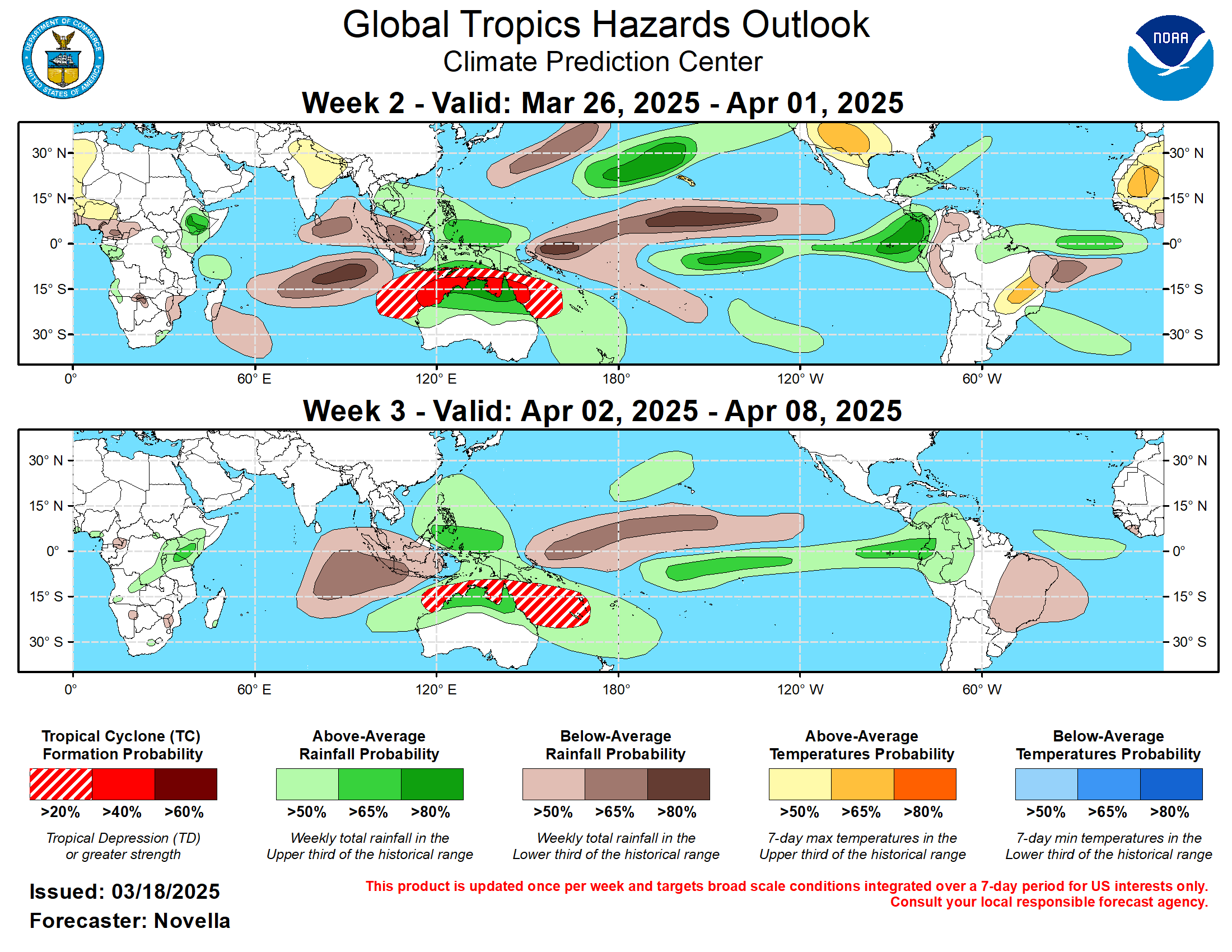This article focuses on what we are paying attention to in the next 48 to 72 hours. The article also includes weather maps for longer-term U.S. outlooks and a six-day World weather outlook which can be very useful for travelers.
First the NWS Short Range Forecast. The afternoon NWS text update can be found here after about 4 p.m. New York time but it is unlikely to have changed very much from the morning update. The images in this article automatically update.
Short Range Forecast Discussion
NWS Weather Prediction Center College Park MD
Fri Sep 06 2024
Valid 12Z Fri Sep 06 2024 – 12Z Sun Sep 08 2024…Dangerous heat continues to impact large sections of the West into this
weekend……Heavy rain and instances of flash flooding are likely throughout the
central Gulf Coast and Southeast over the next few days……Showers and isolated severe thunderstorms possible from the Ohio Valley
to the Lower Great Lakes today…An upper level high pressure system is expected to continue aiding well
above average and potentially dangerous temperatures throughout the West
into the first full weekend of September. Highs today are forecast to soar
into the triple digits for much of the Southwest and interior California,
with 110s in the typically hottest locations of the Desert Southwest.
Meanwhile, daily high temperature records are possible in the Northwest
where mid-to-upper 90s are in the forecast. A minimal relaxing of the
extreme heat should be felt throughout much of the West and Southwest on
Saturday, but with temperatures remaining above average. The core of the
anomalous heat will shift to the northern Great Basin and northern Rockies
as parts of eastern Oregon and Washington experience another day with
highs well into the 90s. Poor air quality will also remain an issue
throughout parts of the northern Great Basin as wildfire smoke continues
to plague the region. Residents and visors are advised to follow proper
heat safety, which includes checking on vulnerable individuals.Not much heavy precipitation to speak of throughout the Nation over the
next few days besides along the Gulf Coast and parts of the Southeast. A
lingering stationary front and a couple waves of low pressure will provide
a focus for tropical downpours over already saturated soils. The greatest
threat for heavy rainfall turning into flash flooding impacts are forecast
across southeast Louisiana today, where a Moderate Risk (level 3/4) of
Excessive Rainfall has been issued. Several inches of rain occurring
within a very short period of time could lead to numerous flash floods
here. A scattered flash flood threat also extends eastward along and just
north of the stationary front into northern Florida and southern Georgia.
This frontal boundary is expected to gradually sink southward by Saturday
as an area of low pressure exits off the Southeast coastline, with a
persisting isolated flash flood potential extending from the central Gulf
Coast and northern Florida to the coastal Carolinas. Remember, most flood
fatalities occur within vehicles… turn around, don’t drown.Elsewhere, a cold front sweeping across the Ohio Valley and Lower Great
Lakes will usher in below average temperatures throughout the Great Lakes,
Midwest, before reaching the East Coast by this weekend, while also
producing areas of showers and thunderstorms. A few storms could produce
locally gusty winds and hail today in the Ohio Valley and nearby Lake Erie
region. Scattered showers are expected to progress eastward along the cold
front on Saturday and dampen weekend plans throughout the Interior
Northeast and sections of New England by Saturday evening.
To get your local forecast plus active alerts and warnings click HERE and enter your city, state or zip code.
Learn about wave patterns HERE.
Then, looking at the world and of course, the U.S. shows here also. Today we are looking at precipitation.
Please click on “Read More” below to access the full Daily Report issued today.
| Notices: What would you like to learn about? Please provide that to me via the comment section at the end of the article. |
Now more detail on the 48-Hour Forecast (It is a 48 to 72 Hour Forecast actually)
Daily weather maps. The Day 1 map updates twice a day and the Day 2 and 3 maps update only once a day. These maps update automatically. But if that does not happen, you can get updates by clicking HERE
TODAY (or late in the day the evening/overnight map will appear) (Key to surface fronts shown on maps and you will then also be able to insert a city name or zip code and get a local NWS forecast).
TOMORROW
NEXT DAY
We have a new animation of the forecast which shows how things may play out over the next 60 hours. To update click ANIMATION. Doing so will get you to the dashboard. You can then step through the animation or hit LOOP on the upper right of the display. You will have to hit the back arrow ← at the top left on your computer to get back into this article. It is a little more trouble than before but I think NOAA scrapped the animation routine I was using so we have to keep up with “progress”.
The NWS Climate Prediction Center’s: Watches, Warnings, and Advisories plus other information can be found HERE. That takes you to the NWC Severe Weather Site. From there you can select among many categories of information. Remember to hit the back arrow ← at the top left of your screen to return to this article.
ATMOSPHERIC RIVERS
This tells us what is approaching the West Coast. Click HERE to update If I have not gotten around to doing the update. Here is some useful information about Atmospheric Rivers.
Below is the current five-day cumulative forecast of precipitation (Updates can be found HERE)
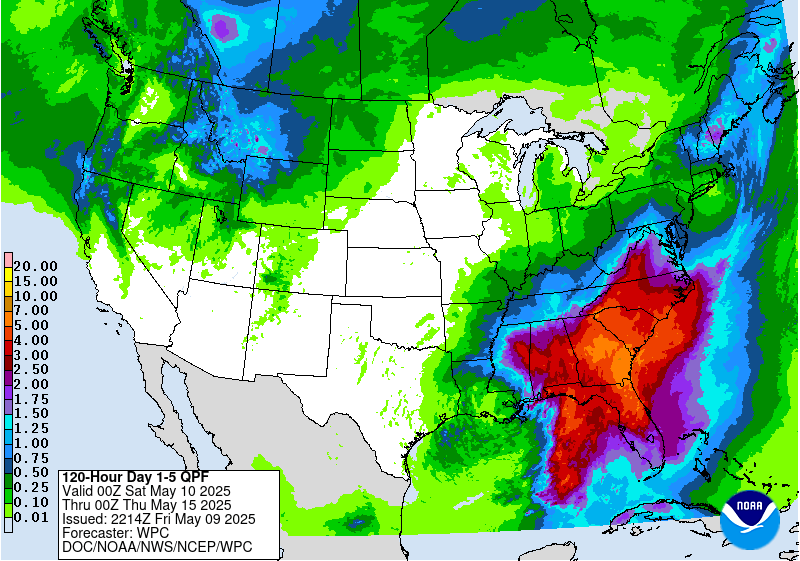
Ski SnowReports will Resume in the Fall.
Now we look at Intermediate-Term “Outlook” maps for three time periods. Days 6 – 10, Days 8 – 14, and Weeks 3 and 4. An outlook differs from a forecast based on how NOAA uses these terms in that an “outlook” presents information as deviation from normal and the likelihood of these deviations.
Below are the links to obtain updates and additional information. They are particularly useful if you happen to be reading this article significantly later than when it was published. I always try to provide readers with the source of the information in my articles. These links may also be useful for those viewing this article on a cell phone or other small screen.
| Days 6 – 10 (shown in Row 1) | Days 8 – 14 (Shown in Row 2) | Weeks 3 and 4 (Shown in Row 3 but updates only on Fridays) |
| https://www.cpc.ncep.noaa. gov/products/predictions/610day/ | https://www.cpc.ncep .noaa.gov/products/predictions/814day/ | https://www.cpc.ncep.noaa.gov/products/predictions/WK34/ |
Showing the actual maps. They should now update automatically. The Week 3 – 4 Outlook only updates on Fridays. So below is what I call the Intermediate-term outlook. On Fridays, it extends out 28 Days. That declines day by day so on Thursday it only looks out 22 days until the next day when the Week 3 – 4 Outlook is updated and this extends the outlook by one additional week.
| 6–
10
|
|
|
| 8–
14 |
|
|
| 3–
4 |
|
|
HAZARDS OUTLOOKS
Click here for the latest complete Day 3 -7 Hazards forecast which updates only on weekdays. Once a week probably Monday or Tuesday I will update the images. I provided the link for readers to get daily updates on weekdays. Use your own judgment to decide if you need to update these images. I update almost all the images Friday Night for the weekend edition of this Weather Report. So normally readers do not need to update these images but if the weather is changing quickly you may want to.
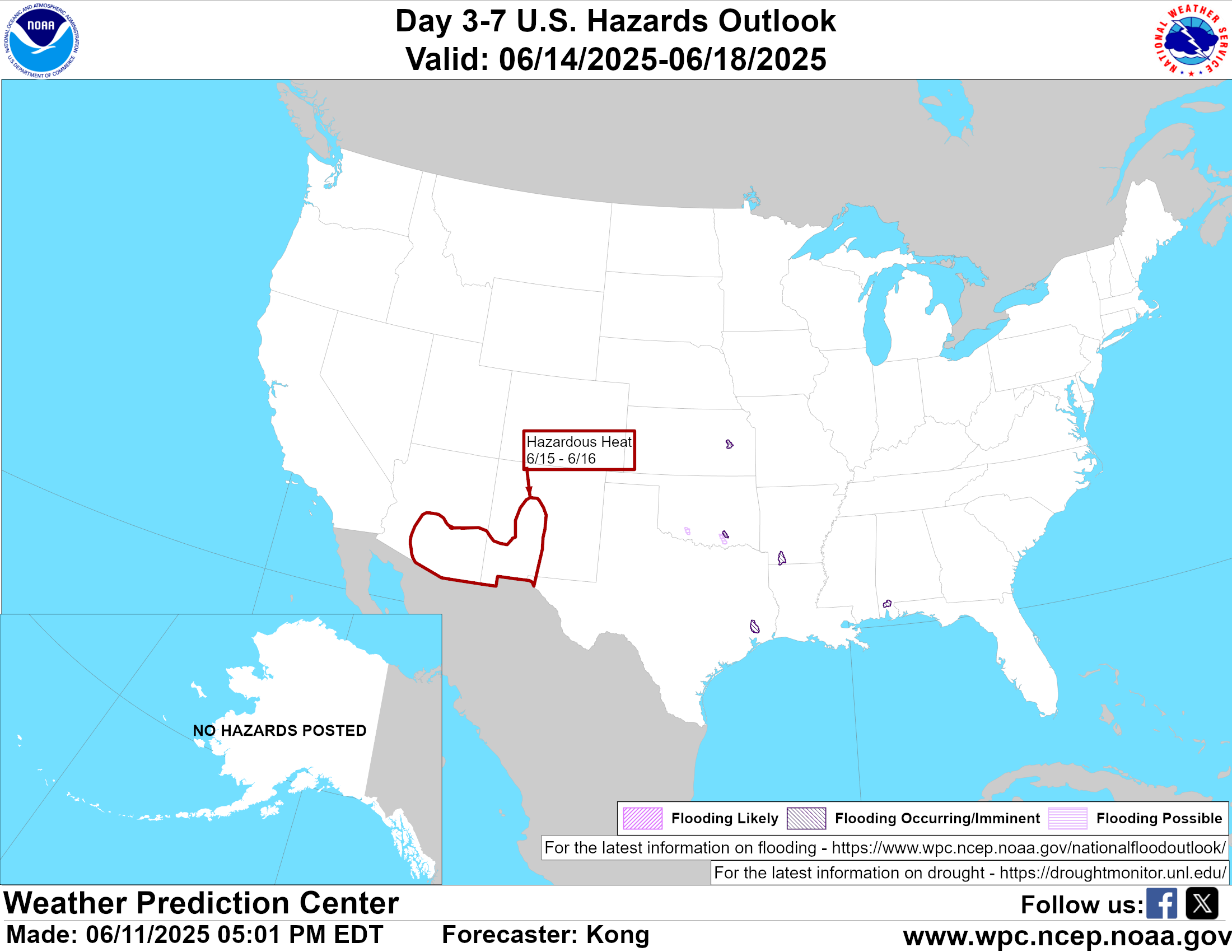
Temperature month to date can be found at https://hprcc.unl.edu/products/maps/acis/MonthTDeptUS.png
Precipitation month to date can be found at https://hprcc.unl.edu/products/maps/acis /MonthPNormUS.png
World Forecast [that website is has been intermittent so be patient]
Below are the Day 1 -3 and 4-6 forecasts for temperature and precipitation. Updates and much additional information can be obtained HERE
World Temperature Anomalies

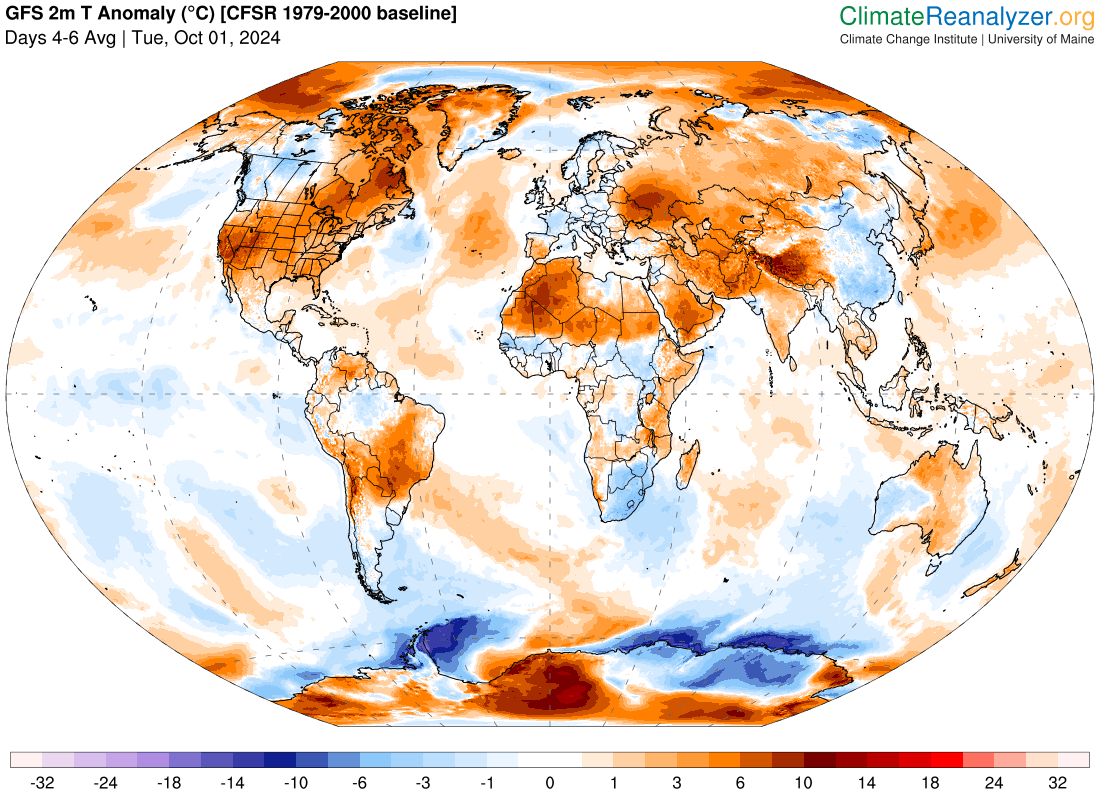
World Accumulated Precipitation
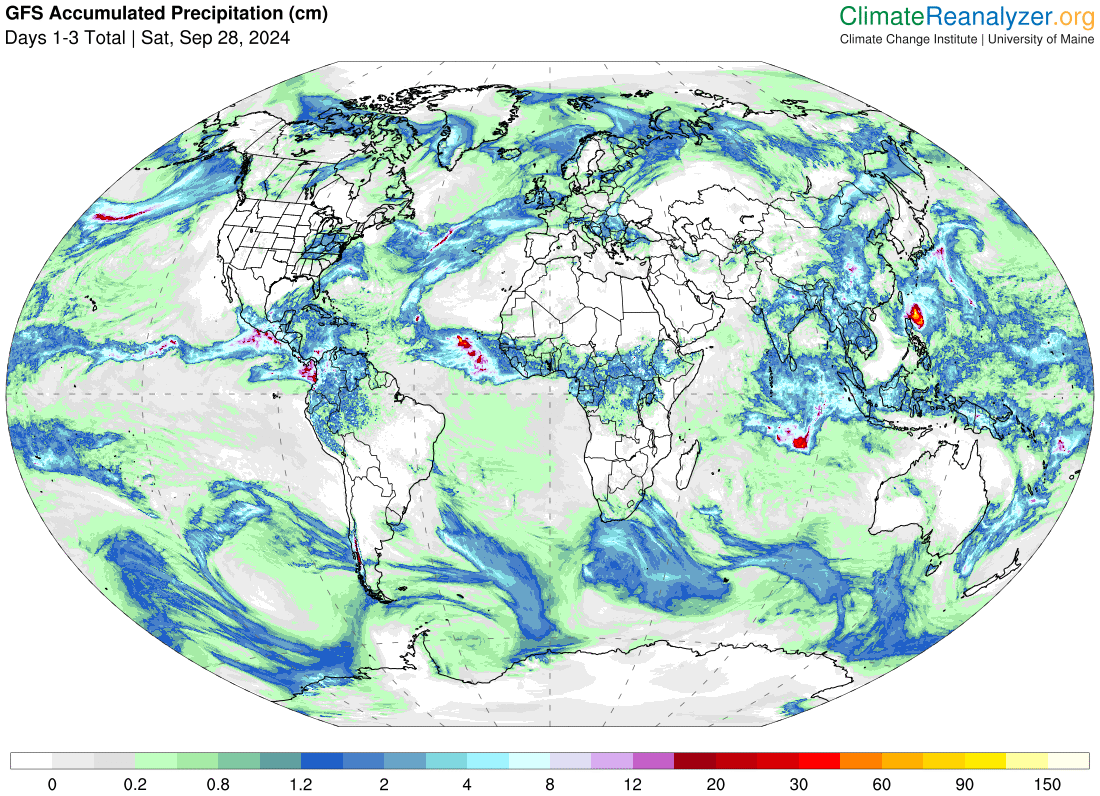

This information is provided by the University of Maine. They draw upon many different sources. There is a lot of information available at the link provided. I have just provided two useful forecasts. There are probably over a hundred different forecasts available from this source.
Worldwide Tropical Forecast (This is a NOAA Product)
This graphic updates on Tuesdays) If it has not been updated, you can get the update by clicking here Readers will only have to do that if they are reading this article much later than the date of it being published.
Information on Tropical Storms can be found HERE. Western Pacific information can be found HERE. Note that unless there is an out-of-season storm the below images will not update until the National Hurricane Center starts their seasonal update of these maps on June 1. I include them simply because there can be an out-of-season event in which case it should show up in these maps.

–
I hope you found this article interesting and useful. –

